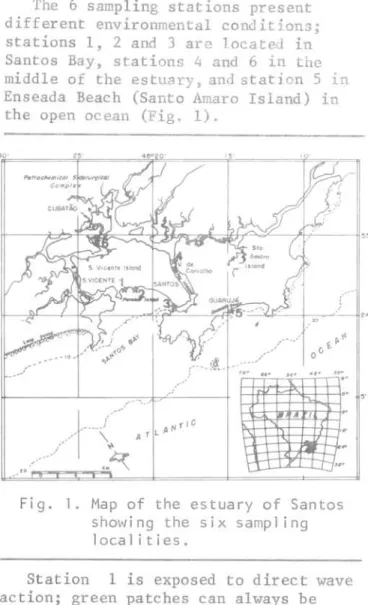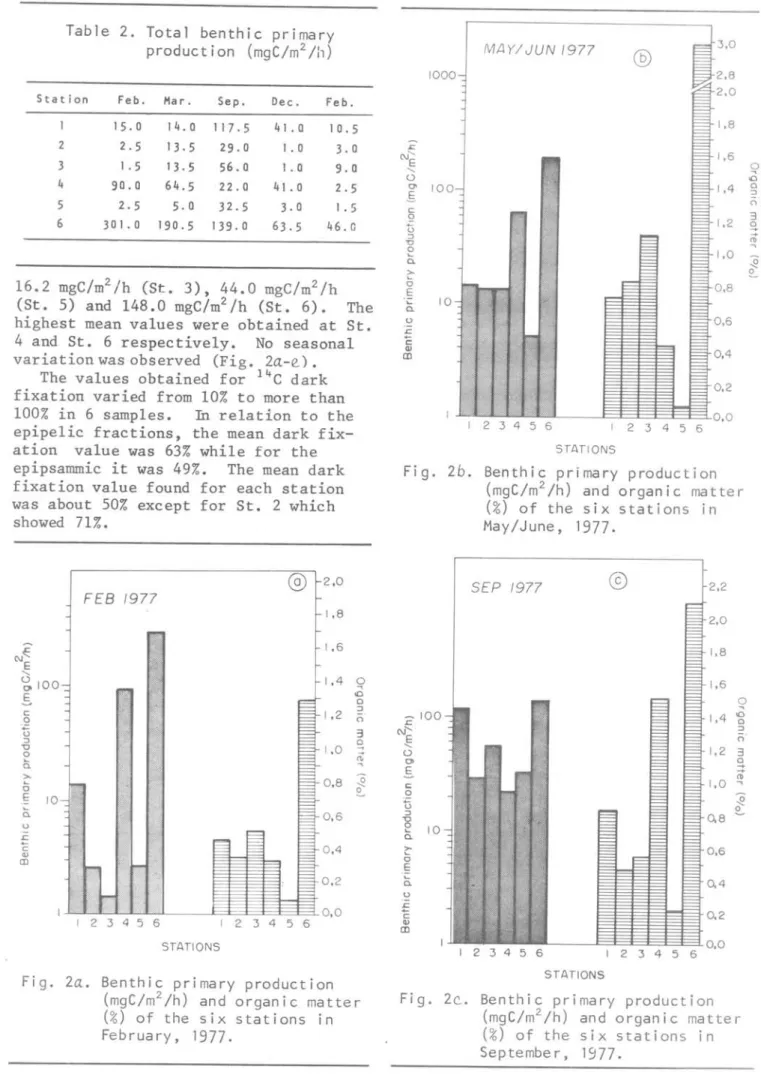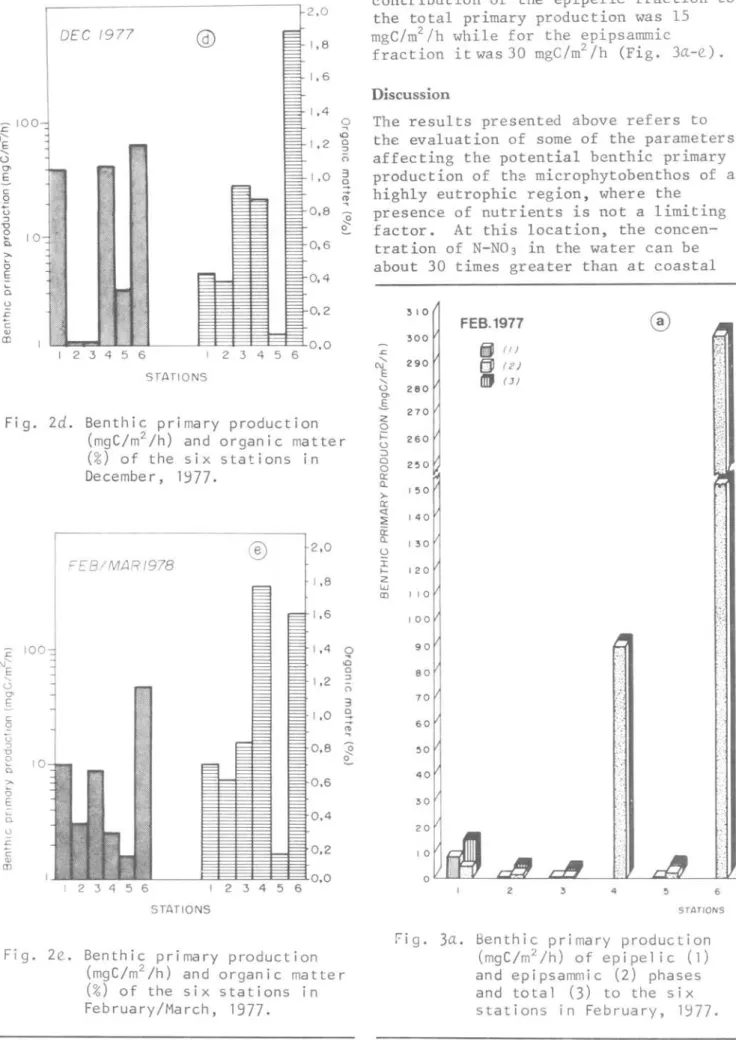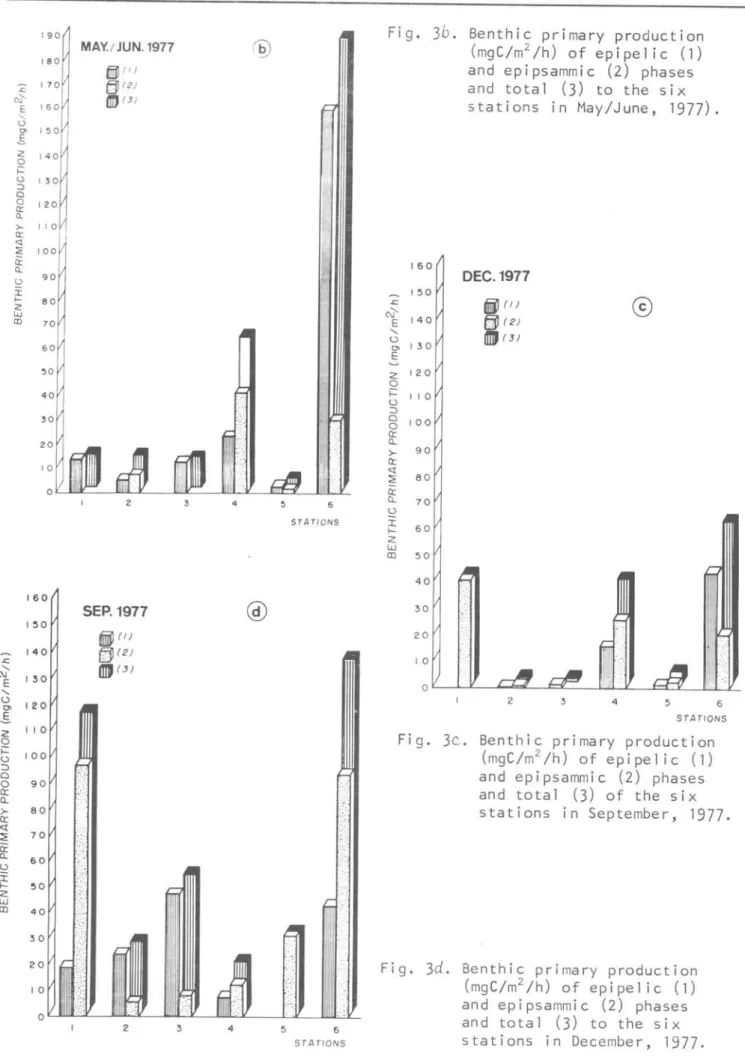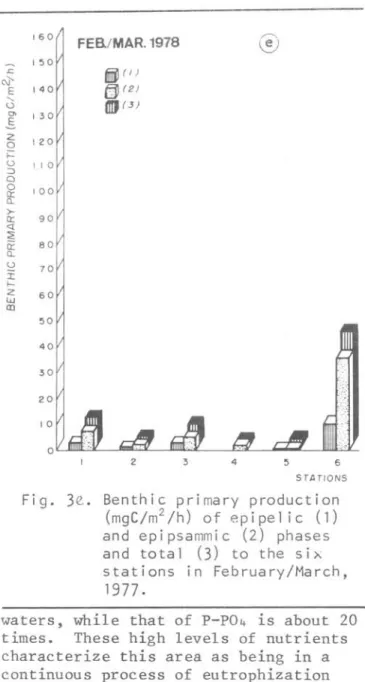PRIMARY PRODUCTION OF THE BENTHIC MICROFLORA LIVING ON INTERTIDAL
FLATS IN THE SANTOS ESTUARINE SYSTEM
(24°S J 46°W)JSÃO PAULO
JBRAZIL
Eduinetty Ceci Pereira Moreira de SOUSA*
Instituto Oceanográfico da Universidade de são Paulo
Synopsis
Estimates of primary production of benthic microflora were" carriedoutin the Santos
tropical estuary~ on the southern coast of Brazil C24°S~ 46°W). The samples were
obtained seasonally over a one-year period. Six stations with different environ~
mental conditions were chosen. The samples~ which consisted of the upper 2 mm of
t he sediment~ were collected in the intertidal zone~ according to Gr~ntved's (1960)
methodology. The mean annual value of primary production was 45 mgC/m2/h~ ranging
from 1~ O to 301. O mgC/m 2/h. The highest values were observed at the more sheltered
stations~ which contained the highest amount of organic material and the highest
input of poUuted material. The epipsammic algae contributed with 40% of the total
production while the epipelic ones contributed with 60%. The mean value for
dark fixation of 14C was 63%.
Oescriptors: Benthos, Micro-organisms, Primary .production, Intertidal zone Sedlments Estuaries
Santos - SP. ' I I
Des c ritores: Bentos, Microrganismos, Produção primária, Zona entre-marés, Sedimentos, Estuãrios,
Santos - SP.
In trod uction
Santos Estuary is regarded as a highly disturbed and polluted environment. The high density of human population, the industrial development and the intense dock activities have induced environ-mental perturbations in the area. The
physical, chemical and biological
properties of the region have extensive-ly studied. In relation to biological aspects the works of Carvalho (1952), Joly (1957), Lima & Vazzoler (1963), CETESB (1978). Gianesella-Galvão (1978), Tommasi (1979) and Monteiro (1980) should be mentioned; the paper of Gianesella-Galvão (op. W.) refers to phytoplankton primary production. This is the first account on phytobenthos primary pro-duction undertaken in Brazil.
Benthic primary production is of fundamental importance in estuarine systems where its contribution to the total primary production is often greater than that of the phytop1ankton
(Hargrove, 1969; Leach, 1970); further-more, the eva1uation of the benthic primary production contributes significant1y to a better under-standing of the energy dynamics of coastal areas.
(*) Aluna de P6s-Graduação do IOUSP.
Pub.t. Yl. 603 do IJlUJt. oc.e.a.YlogJL. da. U-6p.
Research concerned to benthic
primary production has been carried out in polar zones (Matheke & Horner, 1974), in temperate zones (Gr~ntved, 1960, 1962, 1966; Gargas, 1970, 1972, 1980; Steele & Baird, 1968; Leach, 1970; Marshall e.t
al.,
1971; Colocolloff,1972; Cadêe & Hegeman, 1974, 1977), and in tropical zones (Bunt e.t
al.,
1972; Plante-Cuny, 1971, 1973, 1978; Sournia, 1976); however, as far as we are aware, no reference on the subject is avai1able for the coast of Brazil and South America.
The purposes of this study are to evaluate the Santos estuarine system in relation to its potential yield of microbenthic production and to obtain biological information for a better understanding of this estuarine ecosystem.
Description of the sampl ing area
The Santos estuarine system is located on the coast of são Paulo, south-east of Brazil (24°S, 46°W). It is a
tropical estuary with mean annual temperature of 20°C, annual rainfal1 ranging from 2000 - 2500 mm, and mean insolation of 155 hours monthly in the summer and 164 hours month1y in winter
The 6 sampling stations present different environmental conditions;
stations 1, 2 and 3 are located in Santos Bay, stations 4 and 6 in the middle of the estuary, and stad on 5 in Enseada Beach (Santo Amaro Island) in the open ocean (Fig. 1).
30'
,.
J
,,,..---0,.- .-"
._r
\.
,.~
,.'
".
,/~-'.'
,_:_-!~.-
_ .... .//
. ..:,.-
..
- ,..
~.
,
..
..
Fig. 1. Map of the estuary of Santos
showing the six sampl ing localities.
Station 1 is exposed to direct wave action; green patches can always be noticed in the sedimento St. 2 is protected by Porchá Island which is quite close to the beach; near the sampling site there is a sewage outlet. St. 3 is located in the en-trace of Santos Channel, inside the estuary, being under the influence of fresh water, industrial pollutants and wastes from port activities and sewage. At the sediment surface it can be seen a lot of polychaete's tubes from the genera Onup~ and V~opa~a. St. 4 is located in front of the port area. In this location, salinity is quite
variable, for it is affected by the fresh water that reaches this station and by the tides. Organic wastes of domestic origin and a permanent oil
dark. At this place a subsurface permanent reducing layer of decomposed mater ial appears.
Methodology
For the evaluation of the benthic primary production in the intertidal zone, samples comprising the uppermost 2 mm of t he · sediment were obtained during ebb-tide following the procedure
of Gr~nt ved (1960). In the laboratory,
the epipelic algae were separated from the sediment containing epipsammic algae by successive washings with filtered sea water (Millipore, HA, 45 ~ pore).
Water used for washing was collected in the respective sampling areas. After
240 separat i on of the two alga! fractions,
two sub samples were taken from each frac t i on and were put in light and dark bottles. Each bottle received 1 ml of Na H14C03, 10~Ci of activity. The
volume of each bottle was completed with filtere d sea water. Incubation took place in the laboratory during a period of two hours. The incubator was
provided with fluorescent lamps of about 20,000 lux and had constant temperature. Afterwards these samples were strained through a Millipore, HA, 45~ pore filter to obtain the material which had assimi-lated t he 1 4C•
The amount of 14C assimilated was measured using a Packard Liquid
Scintillation Spectrophotometer Model A-C 2425 Tricarb. The scintillation
solution was prepared with Triton X-lOO and tolluol 1:2, 7.000g PPO and 0.350g POPOP per liter (Bunt
et
al.,
1972).The e fficiency of the scintillation counter varied from 72% to 92% as de-termined by externaI standard ratio.
film cover the sediment surface. It is a shel tered beach with a permanent subsurface reducing layer. St. 5 is the most exposed to wave action, showing a
clean sedimento St. 6 is very sheltered; it is located at Casqueiro River, at the back of the estuary. The salinity here is quite variable, and the sediment is
Environrnental parameters were
determined for each sampling locality. Measurement s of the sea water temper-ature, salinity, dissolved oxygen and estimates of the oxygen saturation leveIs were made. The sediments were ana lysed as to temperature, organic matter content and granulometry. Conductivity measurements were c~rried
Results
Environmental parameters
The water temperature during the study period ranged from 21.0 to 29.5°C whi1e the temperature of the sediment ranged from 22.0 0C to 35°C (Tab. 1). The sa1inity va1ues ranged from 11.4%0 (St. 6) to 34.7%0 (St. 1) (Tab. 1). The disso1ved oxygen va1ues ranged from 4.1 m1/1 (St. 6) to 9.2 ml/1 (St. 5). Oxygen oversaturation was recorded in a11 stations. The percentage of organic matter in the sediment ranged from 0.06%
(St. 5) to 3.00% (St. 6). The highest mean va1ues ~ere found in St. 4 (1.00%) and St. 6 (2.00%) and the lowest in St. 5 (0.12%).
The granu10metric ana1ysis of the sediment gave MZ ~ va1ues of 3.1; 3.5;
3.2; 3.3; 3.0 and 2.8 to Sts 1,2,3,4, 5 and 6 respective1y, ranging from fine
(FS) to very fine sand (VFS) (Tab. 1). A redox 1ayer was visible be10w the
surface at St. 4 and St. 6 throughout the samp1ing period and on1y twice at St. 3; in St. 1, in Sts 2 and 5 it was not present.
Benthic primary production
During the study period the diatoms dominated over the other members of the microphytobenthos and were about 90% of
the who1e microf1ora popu1ation. The benthic primary productivity va1ues obtained durin~ the study period varied from 1.0 mgC/m /h to 301.0
mgC/m2/h. (Tab. 2). The mean va1ues
obtain.ed in each station were 39.6
2
mgC/m /h (St. 1), 9.8 mgC/m2/h (St. 2),
Table 1. Environmental parameters
Stations 2 4 5 6 2 4 5 6 2 3 4 5 6 2 4 5 6 2 4 5 6 Tide (mm)
+0 . 4 +Q.4 +0.4 +0.4 +0 . 4 +0.4 +0.4 +0.4 +0.4 +0.3
+ 0.3
+0.3
O. O
0.0 O. O O. O O. O O. O
+0.4 +0.4 +0.4 +0.3 +0.3 +0.3 +0.1 +0. 1 +0. 1 +0.3 +0.3 +0.3 \oIater (TOe) 25. O 25.0 25.0 25.0
25. O
25.0 25.0 25.0 25.5 25.0 25.0
25 . O
21 . O
22.0
23. 5 23. O
24.0
27 . O
23.5
23.0
25.0
25. O
25.5
26.0 28.0 29.5 29 . 0 27.0 28.0 29.0 Sediment (TO e) 24.0 25.0 24 . 0
23. O
24.0 24.0 23.0 24.0
24. O
24.0 25.0
24. O
22. O 23.0 24.0 23. O 24.0 26.0
25. O
27.0 28 .0 26.0 25. O 26.0 32.0 32.5 35. O 28.0 29.0
3 O • O
Salinity
(0 / 00)
J4.7
2B.3 21 . 1 30.9 31 .2
26.5 30.9 31.2 26.5 34.7 28.3 21 . O
32 . 8
31 . 9
29.2 24.9 33.7 17.1 Z7.7 27·3 21 .9
17.8
32.3
11 .4
31.2 27.5 31 • 1
22.~
3 O . 4
19 . 3
Dissolved oxyaen
em 1 i 1 )
6.5
7. 3
6.6 7.6 6.9 (, . 9 7.6 6.9 6.9 6 . 5 7.3 6.6 8.5
8.8
7.5 6 . 7
8. 1 4. 1 7.7 8. O 6.9 5.7 8.4 4. 3 8.9 6. O 6 . O 7. O
9.2
Saturat ion leveI of oxygen(ml/l)
4.7 4.9
5 . 1
4.8 4.8 5. O 4.8 4.8 4.9 4.7 4.9 5. 1
5 . 1 5. O 5. O 5.2 4.8 5. O 5. 1 5. 1 5. 1 5.2 4.9 5.3 4.6 4.6 4.5 4.9 4.6 4 . 8
Organic ma t e c i a 1
content ( %)
O. 5
0.3
0.5
O. 3
0.09 1 .3
0.7 0.8
1.1
O. 4
0.07 3. O 0.8 0.5 0.5 1 .5 0.2
2. 1
0.4
O. 4
1 • O
Table 2. Total benthic primary production (mgC/m2 li,)
Station Feb. Ma r. Sep. Dec. Feb.
15. O 14. O 117.5 41. O 10.5 2 2.5 13.5 29.0 1.0 3. O 3 1.5 13.5 56.0 1 .0 9. O 4 90.0 64.5 22.0 41 • O 2.5 5 2.5 5. O 32.5 3. O 1.5 6 301. O 190.5 139. O 63.5 46. ()
16.2 mgC/m2/h (St. 3), 44.0 mgC/m2/h
(St. 5) and 148.0 mgC/m2/h (St. 6). The
highest mean va1ues were obtained at St. 4 and St. 6 respective1y. No seasona1 variation was observed (Fig. 2a-e.).
The va1ues obtained for 14C dark fixation varied from 10% to more than 100% in 6 samp1es. Ih re1ation to the epipe1ic fractions, the mean dark fix-ation va1ue was 63% whi1e for the epipsammic it was 49%. The mean dark fixation va1ue found for each station was about 50% except for St. 2 which
showed 71%.
2.0
FEB 1977
1.8
N€. 1.6
E
,
1.4 ~
~ 100 <O
E o
:J
c: 1.2
o ()
~
U 3
:J
e
"
1.0~ (l;
Q. ,
>- 0.8 ~
'-o ~
E 10
'-Q. 0.6
u
E c: 0 ,4
<1J
(J)
0.2
0.0
I 2 3 4 5 6 I 2 3 4 5 6
STATIONS
Fig. 2a. Benthic primary production
(mgC/m2/h) and organic matte r
(%)
of the six stations in February, 1977 .M4YIJU N 1977 3.0
®
1000 2.8
2.0
1.8 .r:
N' 1.6
E ~
,
Ü <O
O> 10 1.4 :J o
§. ()
c: 3
Q 1.2
e
õ
:J ;;
"O ,
~ 1.0
~
o.
~ ~
o 0.8
E '- 10 o.
u 0.6
.r::.
ê
Q)
0.4
III
0.2
O I 2 3 4 5 6 I 2 3 4 5 6
STATIONS
Fig. 2b. Benthic pri mary production
(mgC/m2/h) and organic matte r
(%)
of the six stations in May/June, 1977 .SEP /977
@)
2.22.0
1.8
1.6
O ,
~ 100 1.4 <O
.r::. o
N' :J
E ()
, 1.2 3
ü
e
O>.§. ;;
1.0 ,
~
o
~
n
:J ~0.8
"
o 10a.
~ 0.6
o
§
.... 0.4
Q.
u
~ c: 0.2
<1J
(J)
0.0
I 2 3 4 5 6 I 2 3 4 5 6
STATlONS
Fig. 2c. • Benthic pr i mary producti on (mgC/m2/h) and organic matte r
'2 100
N'
-ê
o
o-E
c
º
Õ :::J "O
o Q.
."..
Õ
E
o.
~
L:
C
..,
CD
10
DEC /977
I 234 5 6 123 456
STATlONS
2.0
4
.0
o
.o
o :::J
()
3
o
;;; ...
Fig.
2d.
Benthic primary production (mgC/m2/h) and organic matter(%)
of the six stations in December, 1977.®
2.0FEB/MAR/978
1.8
1.6
:2 100 1.4 Q
N' .o
E o
"- 1.2 :::J
o ()
o-E 3
1.0 o
c
-<:>
'"
õ :::J ...
0.8
:ê
"O
2 10 !:.
o.
>- 0.6
Õ
E
~ 0.4
o. ':'
L:
c 0.2
(l)
CD
O I 2 3 4 5 6 I 2 3 4 5 6
STATIO NS
Fig. 2e. Benthic primary production (mgC/m2/h) and organic matter
(%)
of the six stations in February/March, 1977.During the study period the mean contribution of the epipelic fraction to the total primary production was 15
mgC/m2/h while for the epipsammic
fraction it was 30 mgC/m2 Ih (Fig. 3a-e).
Discussion
The results presented above refers to the evaluation of some of the parameters affecting the potential benthic primary production of the microphytobenthos of a highly eutrophic region, where the
presence of nutrients is not a limiting factor. At this location, the concen-tration of N-N03 in the water can be
about 30 times greater than at coastal
.c.
"-N
E "-U
0-.§.
2:
o f= u :::>
o o a::
Q
>-a::
<:!
~
a::
Q
o :r:
I-2:
Lu
CIl 310
FEB.1977 300
mJ
(I)290 tj (2)
l1IJ
(3) 280270
260
2~0
I ~O
140
130
120
I 10
100
90
80
70
60
~O
40
30
20
10
o
2 3 6
STATIONS
r-ig.
3a.
Benthic primary production (mgC/m2/h) of epipel ic (1)and epipsammic (2) phases and tota 1 (3) to the 5 i x
190
180
170
.t::. C\j'
.c
,
(\J
E
,
E 160
,
<.) O> I 5 o
.s
6
140i=
<.) 130
:)
a
~ 120
Q
>- 110
a:
<:J:
::;; 100
a:
Q <.)
:r:
o-2:
LU CD
90
80
70
60
50
40
30
20
10
O
160
1!l0
140
1:50
~ 120
.s
2:
O f= u
::J
a
O
a:
Q
>-a:
<:(
:E
~
u i
I 10 100
90
80
70
60
f... !lO
Z
W
(IJ 40
:50
20
10
O
MAY. / JUN. 1977
2
SEP.1977
mJ
(I)tJ
(2)mJ
(J)2
I
II
3 4 5 6
STATIONS
4 5 6
STATIONS
Fig.
36.
Benthic primary production (mgC/m2/h) of epipel ic (1)and epipsammic (2) phases and total (3) to the six stations in May/June, 1977).
160
1!l0 .c
(\J'
E 140
,
U O>
E 130
Z 120
O
f= u
::J
a
O
a:
Q
I 10 100
>- 9 O
a:
<:(
:E BO
g:
u
:r:
f...
z W
(IJ
70
60
50
DEC.1977
2 3 4 5 6
STATIONS
Fig. 3c.. Benthic primary production (mgC/m2/h) of epipel ic (1)
and epipsammic (2) phases and total (3) of the six stations in September, 1977.
Fig. 3d. Benthic primary production
(mgC/m2/h) of epipel ic (1)
160
FEB./ MAR. 1978
®
I~O
.c
íiI
(I)C\I'
E 140 éj (2)
'-u mJ(3)
o- 130
.s
2 120
O f= u
:::> I I O a
O 100
Q: Q
>-Q: 90
q
~
n: BO
Q
U 70
:r:
f-2 60
LU
Q)
~O
40
30
20
10
O
2 3 4 5 6
STATIONS
Fig.
3e. .
Benthic p r i ma ry production (mgC/m2/h) of ep i pe 1 i c (1)and epipsammic (2) phases and total (3) to the six stations in February/March,
1977 .
waters, whi1e that of P-P04 is about 20 times. These high 1eve1s of nutrients characterize this area as being in a continuous process of eutrophization
(Gianese11a-Ga1vio, 1978).
The va1ues given here for benthic primary productivity represent the sum of the va1ues for productivity of the a1gae fixed to sand grains (psammophytic a1gae) and those for free ones
(pseudobenthic a1gae).
The highest va1ues for benthic primary production were found at Sts 4 and 6 which are subject to 10wer
hydrodynamism, higher amounts of organic matter and higher percentages of c1ay in the sedimento St. 5, the 1east exposed to these factors, showed low va1ues and 10wer variation in benthic primary production during the period of study. At Sts 1, 2 and 3, 10cated in Santos Bay, a 1arge range of variations was obtained for benthic primary
production, probab1y owing to the
greater environmenta1 variation the bay is subject to, as a resu1t of the
inf10w of continental water from channe1s with a more or 1ess po11uted contento
No seasona1 variation of the benthic primary productivity was found in the Santos estuarine system. Gr~ntved
(1960), Taylor (1964), Hunding (1971), Cadêe
&
Hegeman (1974) and Gargas (1980), working undér very different conditions, regarding latitude and clima te, have found a significant benthic primary productivity seasona1ity.The drop in benthic primary produc-tivity observed in December 1977 and February/March 1978 may have occurred as a resu1t of the weather factors
inf1uencing the environment at that time. In December 1977, rainfa11
reached 149 mm during two days preceding samp1ing. This intense rain must have washed nutrients and a1gae out of the sedi-ment (Colijn & Dijkema, 1981). On the other hand, in February/March 1978, the
temperatures recorded were the highest for the who1e samp1ing period. At this time temperature must have been a
1imiting factor for the benthic primary production (Rasmussen e.~
at.,
1983).The va1ue for benthic primary pro-duction at station 4 in February/March 1978 was a1so 10w. Two days before samp1ing, there had been an oi1 spi11 at this site.
In the Santos estuary area, during the who1e study period, · the pseudo-benthic fraction accounted for 40% of total primary production, whi1e the psammophytic fraction accounted for 60%. It was observed that on the exposed beaches 33.5% of a11 production was due to pseudobenthic a1gae, whi1e on the she1 tered beaches this fraction accounted for 38%. According to Gr~ntved (1962), p1aces more exposed to the direct action of waves show 10wer percentages of free organisms, as these are easi1y washed away by the sea. Gr~ntved
(ap.
~.I
found a variation of 6.6-51.3% for the share of free a1gae in total primary production, depending on whether the site was she1tered or exposed.present results were those for pseudo-benthic algae. The highest percentage of dark fixation of 14C was that
ob-tained at St. 4, where the mean value was 97%. According to Meadows
&
Anderson (1968), bacteria attached to sand grains are responsible for a large part of this fixation.The results for benthic primary productivity during the period of study and for alI stations sampled varied between 1 mgC/m2/h and 301 mgC/m2/h.
When working in the Wadden Sea, Gr~ntved
(1962) found a potential benthic primary productivity which varied between 37 mgC/m2/h and 450 mgC/m2/h. Van Raalte
~t
al.
(1974), in Massachusetts, performed in ~~ experiments giving a variation between 21.9 ± 2.6 mgC/m2/hand 64.8 ± 0.7 mgC/m2/h. Grqmtved
(1962), again studying the same location as mentioned above, obtained a mean value of 95 mgC/m2/h for a permanently
covered zone and an intertidal zone. Hunding (1971) also obtained values which were compatible with these intervals, working on an eutrophic lake in Denmark with extremes between 9.0 mgC/m2/h and
145.5 mgC/m2/h. Considering the
differ-ences in latitude and climate between the locations where those authors have worked and the Santos area it can be
stated that the results obtained here are in the same range of variation. Acknow ledgemen ts
Thanks are due to alI those who have assisted in this study. Thanks to Prof. Dr Luiz Roberto Tommasi, Dr Hilda de Souza Lima Mesquita and Dr Jorge Alberto Petersen (in memoriam) who criticise
this work. Thanks to Fundação de Amparo
ã Pesquisa do Estado de são Paulo that supported this research.
Resumo
Estimativas da produtividade primária bentônica foram efetuadas no estuário tropical de Santos, na costa do Brasil
(24°S, 46°S).
As amostras foram obtidas sazonalmen-te, durante um período de 1 ano. Seis estações com diferentes condições am-bientais foram escolhidas para a amos-tragem. As amostras, compreendendo os 2 mm superficiais de sedimento, foram coletadas na zona entre-mares, de acor-do com a metoacor-dologia de Gr~ntved (1960).
O valor medio de produção primária
bentônica obtida foi de 45 mgC/m2/h,
va-"riando entre 1,0 e 301,0 mgC/m2/h. Os
valores anuais mais elevados foram obti-dos nas estações mais abrigadas que con-tinham o maior teor de materia orgânica e estavam sujeitas ao maior afluxo de poluentes. As algas epipsâmicas contri-buíram com 40% para a produção total en-quanto, as epipelicas, com 60%. O valor medio obtido para fixação do 14C no es-curo, durante o período de estudo, foi de 63%.
References
BUNT, J. S.; LEE, C. C.
&
LEE, E. 1972. Primary productivity and related data from tropical and subtropical and marine sediments. Mar. Biol., 1 6 Cl) : 28-3 6 .CADgE, G. C.
&
HEGEMAN, J. 1974. primary production of the benthic microflora living on tidal flats inthe Dutch Wadden Sea. Neth. J. Sea Res., 8(2/3):260-291.
1977 . Distribution of the primary
pro-duction of the benthic microflora and accumulation of organic matter on tidal flat area, BalgZand, Dutch Wadden Sea. Neth. J. Sea Res., 11(1): 24-41.
CARV~LHO, J. P. 1952. Sôbre uma cole-çao de copepodos, não parasíticos, da baía de Santos e suas adjacências. Bolm Inst. oceanogr., S Paulo,
3 (1/2): 131-187.
CETESB. 1978. Poluição das águas no estuário e baía de Santos. são Pau-lo, Companhia de Tecnologia e Sanea-mento Ambiental, 7lp.
COLOCOLLOFF, M. 1972. Recherches sur la production primaire d'un fond sableux. 2. Biomasse et production. These de specialite. Aix-Marseille. 98p.
COLIJN, F.
&
DIJKEMA, K. 1981. Species composition of benthic diatoms and distribution of chlorophyll-a on an intertidal flat in the Dutch Wadden Sea. Mar. Eco1. Prog. Ser., 4:9-21. GARGAS, E. 1970. Measurements ofmicro-benthic algae 1n 0resund. Ophelia, 8:231-258.
GARGAS, E. 1972. Measurements of microalgal primary production (phyto-plankton and microbenthos) in the Malands Havet. (Denmark). Ophelia,
10:75-89.
1980. Production and photosynthetic efficiency of micro-algae (phytoplankton and microbenthos)
in a shallow Danish fjord. Vatten, 36/2: 125-138.
GIANESELLA-GALVÃO, S. M. F. 1978. Produção primária da baía de Santos, Estado de são Paulo: aspectos sobre a eficiência fotossintêtiea em um ambiente marinho poluído. Disserta-ção de mestrado. Universidade de são Paulo, Instituto Oceanográfico, 53p. (não publicado).
GRI~NTVED, J. 1960. On the productivity
of microbenthos and phytoplankton in some Danish fjords. Meddr Danm. Fisk.-og Havunders., n.s., 3(3):55-92.
1962. Preliminary report on the productivity of microbenthos and phytoplankton in the Danish Wadden Sea. Meddr Danrn. Fisk.-og Havunders., n. s., 3 (12): 347-378.
1966. Productivity of the microbenthic vegetation of the Danish Wadden Sea (Abstract). Veroff. Inst. Meeresforsch. Bremerh., Sonderbd.
2:275-276.
HARGRAVE, B. T. 1969. Epibenthic algal production and community respiration in the sediments of Marion Lake. J. Fish. Res. Bd Can., 26:2003-2026. HUNDING, C. 1971. Production of
benthic microalgae in the littoral zone of an eutrophic lake. Oikos, 22:389-397.
JOLY, A. B. 1957. Contribuição ao co-nhecimento da flora ficolõgica mari-nha da baía de Santos e arredores. Tese de livre-docência. Universida-de Universida-de são Paulo, FaculdaUniversida-de Universida-de Filo-sofia, Ciências e Letras, 196p.
LEACH, J. G. 1970. Epibenthic algal production in an intertidal mud flat. Limnol. Oceanogr., 15(4):514-521.
LIMA, F. R.
&
VAZZOLER, A. E. A. de M. 1963. Sôbre o desenvolvimento das ostras e possibilidades da ostreicul-tura nos arredores de Santos. Bolm Inst. oceanogr., S Paulo, 13(2):3-20. MARSHALL, N.; OVIATT, A.&
SKAUEN, D. M.1971. productivity of the benthic microflora of shoal estuarine en-vironments in southern New England. Int. Rev. ges. Hydrobiol., 56(6): 947-956.
MATHEKE, G. E. & HORNER, R. 1974. primary productivity of the benthic microalgae in the Chukchi Sea near Barrow, Alaska. J. Fish. Res. Bd Can., 31(11):1779-1786.
MEADOWS, P. S. & ANDERSON, J. G. 1968. Microorganisms attached to marine
sand grains. J. mar. biol. Ass. U.K., 48:161-175.
MONTEIRO, A. M. G. 1980. A macrofau-na do infralitoral superior das praias de Santos e são Vicente. Dissertação de mestrado. Universi-dade de são Paulo, Instituto
Oceano-gráfico, l27p.
PLANTE-CUNY, M. R. 1971. Utilisation du 14C pour l'êvaluation de la production primaire dans les
sêdiments marins. r~: L'enêrgie nu-clêaire et ses applications biolo-giques
ã
Madagascar. Colloque, Tanarive, mai 1971. Terre malg., n. spêc., 12:269-283.1973. Recherches sur la produc tion primaire bentique en milieu marin tropical. I
-Variations de la production primaire et des teneurs en pigments photo-synthêtiques sur quelques fonds sableaux. Valeur des rêsultats obtenue par la mêthode du 14 C. Cah. O.R.S.T.O.M., sêr. Oceanogr., 11 (3) :317-348.
d'une reg~on tropi cale (Nosy - Be, Madagascar). Trav. Doc. O.R.S.T.O.M.,
(96) :1-3 59 .
RASMUSSEN, M. B.; HENRIKSEN, K. &
JENSEN, A. 1983. possible causes of temporal fluctuations in primary production of the microphytobenthos in the Danish Wadden Sea. Mar. Biol., 73(2):109-114.
SANTOS, E. O. 1965. Características clímaticas. In: A baixada santista: aspectos geográficos. são Paulo, EDUSP, vol. 1, p. 951-150.
SOURNIA, A. 1976. primary production of sands in the lagoon of an atol1 and the role of foraminiferan
symbionts. Mar. Bio1., 37(1):29-32. SUGUIO, K. 1973. Introdução
ã
sedimen-to1ogia. são Paulo, Edgard B1ücher/ EDUSP, 317p.
STEELE, J. H.
&
BAIRD, I. E. 1968. Production eco1ogy of a sandy beach. Limno1. oceanogr., 13(1):14-25.TAYLOR, R. W. 1964. Light and photo-synthesis in intertida1 benthic diatoms. He1go1ander wiss. Meeresunter., 10:29-37.
TOMMASI, L. R. 1979. Considerações ecológicas sobre o sistema estuarino de Santos (SP). Tese de livre-docên-cia. Universidade de são Paulo, Instituto Oceanográfico, 2 vo1s. UNESCO 1973. A guide to the
measure-ment of marine primary production under some specia1 conditions. Monogr. oceanogr. Methodo1.,
(3):1-73.
VAN RAALTE, C. V.; STEWART~ W. C. & VALIELA, I. 1974. A 1 C technique
for measuring a1ga1 productivity in sa1t marsh muds. Botanica mar., 17:186-188.
